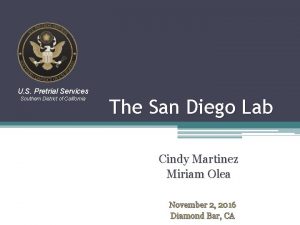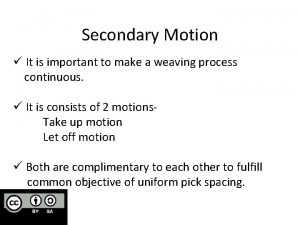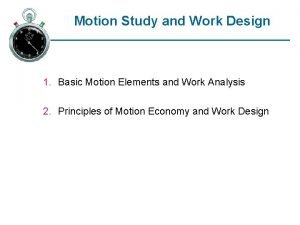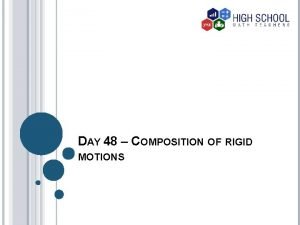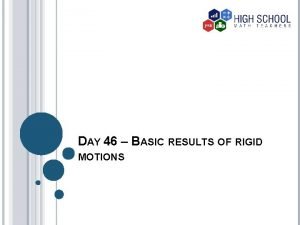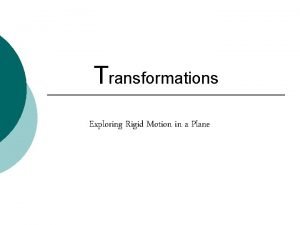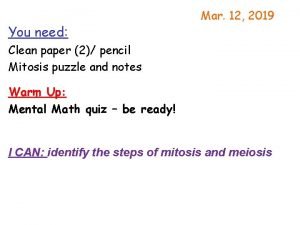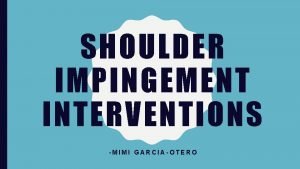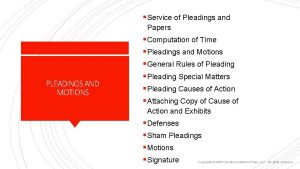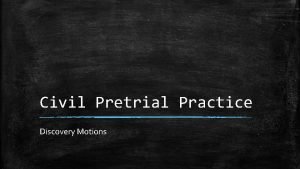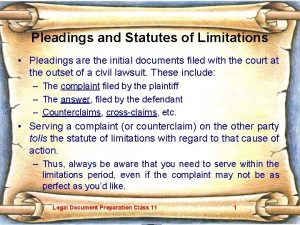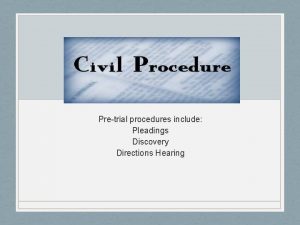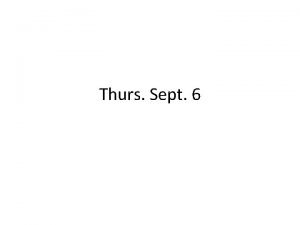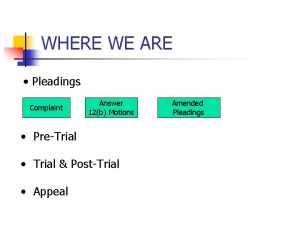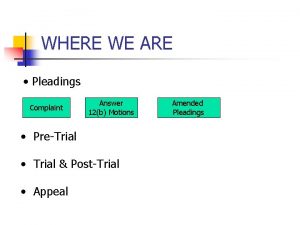Civil Pretrial Practice Responsive Pleadings and Motions Introduction















- Slides: 15

Civil Pretrial Practice Responsive Pleadings and Motions

Introduction to Pleadings – Responding to a Lawsuit Timing and Deadlines Timing for Service of Complaint ▪ The complaint must be served on all named defendants and proofs of service on those defendants must be filed with the court within 60 days after the filing of the complaint. CRC 3. 110(b). – The summons and complaint shall be served upon a defendant within three years after the action is commenced against the defendant. CCP § 583. 210(a). ▪ When the complaint is amended to add a defendant, the added defendant must be served and proof of service must be filed within 30 days after the filing of the amended complaint. CRC 3. 110(b). Proof of Service of Summons Form Timing for Response to Complaint ▪ For most types of lawsuits, the law requires you to file a written response with the court within 30 calendar days after you are served. CCP § 412. 20. – If the 30 th day falls on a weekend or court holiday, you have until the end of the next business day to file your response. CCP §§ 10, 12(a). ▪ The parties may stipulate without leave of court to one 15 -day extension beyond the 30 -day time period prescribed for the response after service of the initial complaint. CRC 3. 110(d).

Introduction to Pleadings – Responding to a Lawsuit Types of Responses 1. You can NOT respond 2. You can file an answer or a general denial 3. You can file a motion • Motion to Strike • Motion to Quash (cancel) service of summons • Motion to stay • Demurrer

Introduction to Pleadings – Responding to a Lawsuit Default Judgment • If you do not file your response in time, the other party may get a default judgment against you. • Step 1: Request for Entry of Default • If a responsive pleading is not served within the time limits specified in this rule and no extension of time has been granted, the plaintiff must file a request for entry of default within 10 days after the time for service has elapsed. The court may issue an order to show cause why sanctions should not be imposed if the plaintiff fails to timely file the request for the entry of default. CRC 3. 110(g). • Step 2: Default Judgment • When a default is entered, the party who requested the entry of default must obtain a default judgment against the defaulting party within 45 days after the default was entered, unless the court has granted an extension of time. The court may issue an order to show cause why sanctions should not be imposed if that party fails to obtain entry of judgment against a defaulting party or to request an extension of time to apply for a default judgment within that time. • • This means that the other party wins the case, and the court will not consider anything you have to say. The other party can begin enforcing this judgment by garnishing your wages, placing liens on your property, or levying your bank account.

Introduction to Pleadings – Responding to a Lawsuit Answer • An Answer is the most common way to respond to a lawsuit. The Answer is the defendant’s opportunity to admit or deny the specific allegations brought against them in the complaint. Any statements in the complaint that are not denied will be taken as true for the purposes of this case. • In the Answer, all defenses to the allegations of the complaint must be raised, and all facts essential to supporting a particular defense must be included. • In addition to asserting denials, an Answer may assert any “new matters” constituting a defense. CCP § 431. 30(b)(2). These are called “Affirmative Defenses. ” If you do not raise a particular defense in your Answer, you will be prohibited from using or raising it later. See Ekstrom v. Marquesa at Monarch Beach Homeowners Ass'n, 168 Cal. App. 4 th 1111 (2008). Answer to Complaint Form

Introduction to Pleadings – Responding to a Lawsuit General Denial • A General Denial is a simple response to a lawsuit. In one sentence, the defendant denies every allegation in the complaint. The defendant may also state new matters as affirmative defenses to the complaint. • General Denials may be used if: 1. 2. the complaint not verified; or the complaint is verified, but is being heard in the limited jurisdiction civil court, unless the case involves a claim for more than $1000 that has been assigned to a third party for collection. • If your case does not meet these guidelines, you will instead use your Answer to admit or deny each allegation. Note: A complaint is considered verified if, in the complaint, the plaintiff swears under penalty of perjury that everything is true and correct. Sometimes the verification will be separate from the complaint; other times it will be included at the end of the Complaint itself. General Denial Form

Introduction to Pleadings – Responding to a Lawsuit Motion to Quash Service of Summons • A Motion to Quash Service of Summons attacks the method the plaintiff used to serve the summons and complaint. • Common grounds for a Motion to Quash include: • • Defect in the method of serving the summons Defect in the summons itself Failure to name the defendant in the summons Failure to serve the summons altogether • A Motion to Quash based on improper service usually will not dispose of a case permanently. • If you win this motion, the plaintiff will probably have to serve you again and then you will have 30 more days to file a response. • If you lose, the court will give you a few days to file your response.

Introduction to Pleadings – Responding to a Lawsuit Motion to Strike • With a Motion to Strike, the defendant asks the court to eliminate specific parts of a pleading, including phrases or individual words. • In limited jurisdiction cases (under $25, 000), parties may only use this motion to attack the “prayer” portion of the complaint, where the plaintiff states the amount of money or relief being requested. • A Motion to Strike is similar to a Demurrer, in that it challenges defects in the complaint. However, the two pleadings challenge different types of defects. A Demurrer is used to challenge the legal sufficiency or clarity of the claims. A Motion to Strike is used to challenge improper or irrelevant information, or complaints not made in conformity with laws, rules, or court orders. Additionally, a Demurrer is used only to attack entire causes of action, while a Motion to Strike can be used to attack portions of a cause of action. • In an unlimited jurisdiction case (over $25, 000), all or part of a pleading may be deleted on the various grounds set forth in CCP § 436, including: • • Material or language that is irrelevant or improper Material, language, or entire pleadings that are not in compliance with state laws or court orders • If the Motion to Strike is sustained with leave to amend the complaint, the Plaintiff can file and serve an Amended Complaint, and the case will proceed. If the Motion to Strike is denied, the defendant may file an Answer.

Introduction to Pleadings – Responding to a Lawsuit Motion to Change Venue or Transfer • A Motion to Change Venue or a Motion to Transfer asks the court to move the case to another court. This can be a court in another county or a different type of court. • Grounds on which venue can be changed include: • • • The case was filed in the wrong court An impartial trial cannot be had in the original court Witness convenience and the ends of justice are promoted by the transfer No judge of the court is qualified to act The case involves the state or a city, county, or local agency • Changing venue does not terminate the case; it merely moves it to a different court.

Introduction to Pleadings – Responding to a Lawsuit Motion to Stay • A motion to stay asks the court to put the case on hold for a while, so that something else can happen. • For example, if you are in the middle of a bankruptcy case, you can file a motion to stay so that the case stops until your bankruptcy case is finalized.

Introduction to Pleadings – Responding to a Lawsuit Cross-Complaints • If you have a claim that arises out of the same transaction, occurrence, or series of events as the plaintiff’s lawsuit, you must file a Cross-Complaint with your Answer. • If your Cross-Complaint is not filed before or at the time you file your Answer, you will need to file complicated paperwork to ask the judge for permission to file your Cross-Complaint Form

Introduction to Pleadings – Responding to a Lawsuit Demurrer: General • A Demurrer is used to tell the court that the allegations in the complaint do not provide legally sufficient reason for the defendant to be sued. A Demurrer questions only the legal sufficiency of the allegations, not their truth or the plaintiff’s ability to prove them. • If the party against whom a complaint or cross-complaint has been filed fails to object to the pleading, either by demurrer or answer, that party is deemed to have waived the objection unless it is an objection that the court has no jurisdiction of the subject of the cause of action alleged in the pleading or an objection that the pleading does not state facts sufficient to constitute a cause of action. CCP § 430. 80(a). • A demurrer to a cause of action may be filed without answering other causes of action. CRC 3. 1320(b). • If the Demurrer is overruled, the Defendant must file an Answer to the original complaint within 10 days CRC 3. 1320(g), (j). • If the Demurrer is sustained with leave to amend the complaint, the Plaintiff can correct the errors in the complaint, serve the Defendant with an Amended Complaint, and the case will proceed. • If the Demurrer is sustained without leave to amend the complaint, the case is usually dismissed.

Introduction to Pleadings – Responding to a Lawsuit Demurrer: Timing ▪ “A person against whom a complaint or cross-complaint has been filed may, within 30 days after service of the complaint or cross-complaint, demur to the complaint or crosscomplaint. ” CCP § 430. 40. ▪ Before filing a demurrer, the parties must meet and confer at least five (5) days before the responsive pleading is due “for the purpose of determining whether an agreement can be reached that would resolve the objections to be raised in the demurrer. ” This same subsection also imposes a further “meet and confer again with the party who filed the amended pleading before filing a demurrer to the amended pleading. CCP § 430. 41(a). ▪ A party filing a demurrer must serve and file therewith a notice of hearing that must specify a hearing date in accordance with the provisions of Code of Civil Procedure section 1005 and, if service is by electronic means, in accordance with the requirements of Code of Civil Procedure section 1010. 6(a)(4) and rule 2. 251(h)(2). CRC 3. 1320(c). – Must be served and filed 16 court days before the hearing date (+ 5 more calendar days if served by mail) (+ 2 more if served by fax, express mail, or overnight delivery). [CCP 1005] Note: CCP 1013 does not apply. ▪ Demurrers must be set for hearing not more than 35 days following the filing of the demurrer or on the first date available to the court thereafter. For good cause shown, the court may order the hearing held on an earlier or later day on notice prescribed by the court. CRC 3. 1320(d).

Introduction to Pleadings – Responding to a Lawsuit Demurrer: Format & Substance All Motions ▪ The papers filed in support of a motion must consist of at least the following: 1. 2. 3. ▪ ▪ ▪ A notice of hearing on the motion; The motion itself and A memorandum in support of the motion or demurrer. CRC 3. 1112(a). Other papers may be filed in support of a motion, including declarations, exhibits, appendices, and other documents or pleadings. CRC 3. 1112(b). The papers filed under (a) and (b) may either be filed as separate documents or combined in one or more documents if the party filing a combined pleading specifies these items separately in the caption of the combined pleading. CRC 3. 1112(c). A motion must: 1. 2. 3. 4. Identify the party or parties bringing the motion; Name the parties to whom it is addressed; Briefly state the basis for the motion and the relief sought; and If a pleading is challenged, state the specific portion challenged. CRC 3. 1112(d) Demurrer Specific ▪ A demurrer shall distinctly specify the grounds upon which any of the objections to the complaint, cross-complaint, or answer are taken. CCP § 430. 60. ▪ Each ground of demurrer must be in a separate paragraph and must state whether it applies to the entire complaint, cross-complaint, or answer, or to specified causes of action or defenses. CRC 3. 1320(a). ▪ A demurrer must state, on the first page immediately below the number of the case, the name of the party filing the demurrer and the name of the party whose pleading is the subject of the demurrer. CRC 3. 1320(e). ▪ The demurrer must include a declaration stating the parties met and conferred and were unable to reach an agreement, or the pleading party failed to respond to meet and confer efforts. CCP § 430. 41(a)(3).

Introduction to Pleadings – Responding to a Lawsuit Demurrer: Legal Standard ▪ ▪ California Code of Civil Procedure § 430. 10, provides in pertinent part: “The party against whom a complaint or cross-complaint has been filed may object, by demurrer or answer as provided in Section 430. 30, to the pleading on any one or more of the following grounds: – (a) The court has no jurisdiction of the subject of the cause of action alleged in the pleading. – (b) The person who filed the pleading does not have the legal capacity to sue. – (c) There is another action pending between the same parties on the same cause of action. – (d) There is a defect or misjoinder of parties. – (e) The pleading does not state facts sufficient to constitute a cause of action. – (f) The pleading is uncertain. As used in this subdivision, “uncertain” includes ambiguous and unintelligible. – (g) In an action founded upon a contract, it cannot be ascertained from the pleading whether the contract is written, is oral, or is implied by conduct. California Code of Civil Procedure § 430. 30(a) provides in relevant part: – “When any ground for objection to a complaint. . . appears on the face thereof , or from any matter of which the court is required to or may take judicial notice, the objection on that ground may be taken by a demurrer to the pleading. ” ▪ A demurrer to the Complaint may be taken to the whole Complaint or any of the causes of action. CCP § 430. 50. ▪ A demurrer tests the legal sufficiency of the Complaint as it raises issues of law, not fact, regarding the form or content of the Complaint. CCP § 589. – For the purpose of testing the sufficiency of the cause of action, the demurrer admits the truth of all material facts properly pleaded (i. e. , all ultimate facts alleged, but not contentions, deductions or conclusions of fact or law). Serrano v. Priest (1971) 5 Cal. 3 d 584, 591. ▪ A general demurrer may lie because the complaint alleges either too little, or too much, where the complaint is incomplete (plaintiffs have failed to allege some "ultimate fact" required to state a cause of action), or, it can be used where plaintiff has included allegations that clearly disclose some defense or bar to recovery. Crosstalk Productions, Inc. v. Jacobson (1998) 65 Cal. App. 4 th 631, 635.
 San diego pretrial services
San diego pretrial services Judge robert tejeda
Judge robert tejeda Civil rights and civil liberties webquest
Civil rights and civil liberties webquest Model un points and motions
Model un points and motions Take up motion
Take up motion A therblig is a basic motion.
A therblig is a basic motion. Composition of rigid motion
Composition of rigid motion Song leader hand signals
Song leader hand signals Ocean motions
Ocean motions Basic rigid motions
Basic rigid motions Size separation pharmaceutics
Size separation pharmaceutics Glide reflection
Glide reflection True motions
True motions Ipmatc mnemonic
Ipmatc mnemonic Mimigarciah
Mimigarciah Culturally responsive teaching and the brain slides
Culturally responsive teaching and the brain slides
